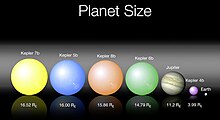Kepler-6
|
Star Kepler-6 |
|||||
|---|---|---|---|---|---|

|
|||||
| Schematic size comparison between Kepler-6 (left) and the sun (right) | |||||
| AladinLite | |||||
|
Observation dates equinox : J2000.0 , epoch : J2000.0 |
|||||
| Constellation | swan | ||||
| Right ascension | 19 h 47 m 20.9 s | ||||
| declination | + 48 ° 14 ′ 23.8 ″ | ||||
| Typing | |||||
| Known exoplanets | 1 | ||||
| Astrometry | |||||
| Radial velocity | (−49.14 ± 0.10) km / s | ||||
| Physical Properties | |||||
| Dimensions | 1.209 ± 0.038 M ☉ | ||||
| radius | 1.391 ± 0.034 R ☉ | ||||
| Effective temperature | 5647 ± 44 K | ||||
| Metallicity [Fe / H] | +0.34 ± 0.04 | ||||
|
Other names and catalog entries |
|||||
|
|||||
Kepler-6 is a star in the constellation Swan that is orbited by an exoplanet with the systematic name Kepler-6b .
The exoplanet Kepler-6b orbits the central star with a period of 3.235 days and is counted among the so-called Hot Jupiters . With a radius of about 1.3 Jupiter radii, it has a mass of about 0.7 Jupiter masses. The exoplanet was within the Kepler mission of NASA using the transit method discovered; its discovery was announced in January 2010.
Web links
- The exoplanet in the "Encyclopedia of Extrasolar Planets"
See also
Individual evidence
- ↑ Simbad. simbad.u-strasbg.fr, July 30, 2012, accessed July 30, 2012 .
- ↑ a b c d e Kepler-6b. exoplanet.eu, July 30, 2012, accessed July 30, 2012 .
